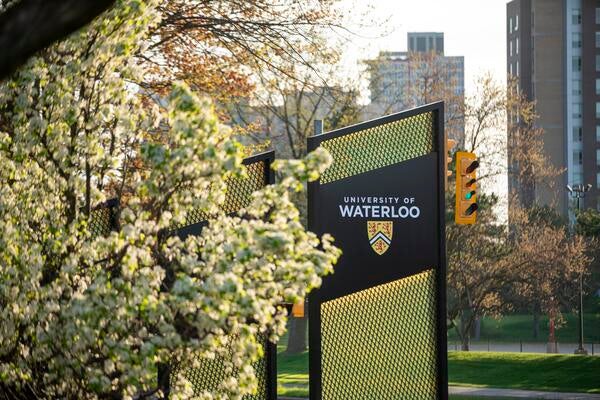
Capstone Design awards help turn projects into businesses
The annual celebration includes awards to support teams that may want to convert their projects into immediate business opportunities

The annual celebration includes awards to support teams that may want to convert their projects into immediate business opportunities
By Beth Cotter Faculty of EngineeringCapstone Design awards are the culmination of the undergraduate student experience, creating a blueprint for innovation in engineering design. At Waterloo Engineering we celebrate with the Capstone Design Symposia spanning two weeks in March.
The annual celebration includes Capstone Design awards to support teams that may want to convert their projects into immediate business opportunities. Ground-breaking ideas leading to the creation of ventures such as Voltera, Suncayr, Athos, BufferBox, Intellijoint HIP, the Myo armband and the Pebble smartwatch all had their geneses in Capstone Design.
For the last five years, as the Capstone Design Symposia wrap up, Waterloo Engineering and the Conrad Business, Entrepreneurship and Technology Centre have hosted the Norman Esch Entrepreneurship Awards. Capstone teams pitch their projects to a panel of judges for one of the six team awards of $10,000 each.
This year’s $10,000 winners were:
Circadian Energy (John Curticapean, Ben Hudson, Tony Qu and Malcolm Williams – mechatronics engineering) for a low-cost hub system to enable neighbours in the developing world to share electricity.
After turning down job offers from the likes of Apple and Tesla, the teammates are pursuing the project full-time, with plans to travel to Tanzania this summer to refine the technology and return for pilot testing next year.
“It had to be something we’d be proud to have our names attached to and that we could work on for a long time,” Curticapean says of their ambitious project choice.
“We really see this changing the world,” adds Williams.
SannTek (Noah Debrincat, Thomas Dunlop, Karolyn Mackowiak, Ben Milligan and Chris Taylor – nanotechnology engineering) for a nanotechnology-based sensor to determine levels of marijuana intoxication from breath samples.
“What police need is a breathalyzer for marijuana – and that’s where we come in,” says Mackowiak.
GreenSorbs (Jack Anderson, Skylar Bone, Olsi Goxhaj and Kien Tran – chemical engineering) for booms made from a polymer fibre in old tires, otherwise destined for the landfill, to absorb and contain oil in the event of spills.
“We’re using a waste product to pick up waste,” says Bone.
PhysioBuddy (Shirley Ng, Kassandra Predovic, Ritu Shah and Elizaveta Vorobieva – systems design engineering) for a wireless sensor band that gives physiotherapy patients feedback to help and motivate them to do their exercises correctly.
“We’re PhysioBuddy – physiotherapy done right,” says Shah.
Qalm (Paul Boyadjian, Shahriar Kabir, Bradon Lui, Thomas Uhlenbruck and Aniket Verma – chemical engineering and environmental engineering) for technology to monitor industrial steam traps and relay information on costly leaks to operators.
“Together we will make invisible failures visible,” says Kabir.
weLite (Diogo de Oliveira Livera, Piaopiao Long, Aswathy Ann Thomas and Gareth Toogood-Holmes – chemical engineering) for a portable, easy-to-use device to clean drinking water in developing countries using a photocatalyst material and sunlight.
“We want to solve the problem of economic water scarcity experienced by millions of people around the world,” says Thomas.
An additional $3,000 for the Sedra People’s Choice Award, as voted on by audience members, went to Hiza (Sanhar Balachandran, Sadruddin Hashmani, Bainian Liu and Nabeel Shahid – systems design engineering) for a system to detect risk factors for non-contact ACL injuries among collegiate athletes.
Also awarded each year is financial support through the Palihapitiya/Lau Venture Creation Fund, which provides $50,000 to promising University-selected Capstone Design teams that intend to transform their projects into startup companies after graduation.
SannTek – also an Esch recipient and a Velocity Fund Finals winner – was selected this year to receive extra support to commercialize its project, a “marijuana breathalyser” that can determine the concentration of tetrahydrocannabinol (THC), the psychoactive component of marijuana, present within a breath sample.
The two-part device, which features a single-use disposable cartridge and a portable analyzer, has undergone user testing at the law enforcement level to establish ease of use and accuracy. Competitive products have proven too fragile or complicated to ensure proper usage and readings, making SannTek’s device a front-runner in the market.
Last year’s recipients of backing from the Palihapitiya/Lau Venture Creation Fund, Vena Medical and VivaSpire, are continuing work to expand the capabilities of their working prototypes.
The list of awards to support Capstone Design projects continues to grow. Please connect with us at Waterloo Engineering if you are interested in supporting our students with a new design award. Existing awards include:
Adel Sedra Entrepreneurship Award for Capstone Design
Autodesk Canada Capstone Design Award
Baylis Medical Capstone Design Awards
Bhattacharyya Capstone Design Award
Design Analysis Competition Sponsored by ANSYS AIM

Read more
The 2025 cohort represents some of the brightest new entrepreneurial minds in STEM

Read more
Jocelyne Murphy, recipient of the 2025 Pearl Sullivan Emerging Global Leaders Award, is helping students around the world connect, create and lead with purpose

Read more
Waterloo Engineering students walk away with over $100,000 to commercialize their innovative business solutions
Read
Engineering stories
Visit
Waterloo Engineering home
Contact
Waterloo Engineering
The University of Waterloo acknowledges that much of our work takes place on the traditional territory of the Neutral, Anishinaabeg, and Haudenosaunee peoples. Our main campus is situated on the Haldimand Tract, the land granted to the Six Nations that includes six miles on each side of the Grand River. Our active work toward reconciliation takes place across our campuses through research, learning, teaching, and community building, and is co-ordinated within the Office of Indigenous Relations.